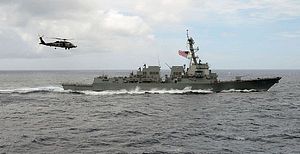In a statement released at the conclusion of the recently held second annual U.S.-China Diplomatic and Security Dialogue, the United States called on China to remove deployed missiles from its artificial islands in a disputed portion of the South China Sea.
“The United States called on China to withdraw its missile systems from disputed features in the Spratly Islands, and reaffirmed that all countries should avoid addressing disputes through coercion or intimidation,” the U.S. statement said.
The statement follows the conclusion of a high-level meeting between U.S. Secretary of State Mike Pompeo, U.S. Secretary of Defense Jim Mattis, Director of the Office of Foreign Affairs of the Central Commission of the Communist Party of China and Politburo member Yang Jiechi, and State Councilor and Defense Minister General Wei Fenghe on diplomatic and security matters between the two countries.
The Diplomatic and Security Dialogue had originally been slated for October, but was postponed amid broader tensions in the U.S.-China relationship stemming from the ongoing trade war between the two countries, U.S. approval of a probable arms sale to Taiwan, a near-collision between a U.S. and Chinese destroyer in the South China Sea, and U.S. imposition of sanctions on a People’s Liberation Army procurement organ in relation to China’s purchase of Russian defense hardware.
In addition to the call on China to remove missiles from the South China Sea, the statement noted that both sides “committed to support peace and stability in the South China Sea, the peaceful resolution of disputes, and freedom of navigation and overflight and other lawful uses of the sea in accordance with international law.”
China and the United States interpret freedom of navigation differently, with Beijing differentiating between navigational rights for military and civilian vessels. China, additionally, opposes military surveillance activities within its exclusive economic zone.
Exposing these differences in interpretation, Yang noted that “There is no such problem of freedom of navigation and overflights being obstructed, so to use this issue as an excuse to military action is unjustifiable.”
“The Chinese side made it clear to the United States that it should stop sending its vessels and military aircraft close to Chinese islands and reefs and stop actions that undermine China’s sovereignty and security interests,” he added.
In October, a U.S. guided-missile destroyer, USS Decatur, was involved in a near collision with a People’s Liberation Army-Navy Type 052C destroyer, the Lanzhou, after it tried to interrupt an innocent passage freedom of navigation operation near Gaven Reef in the South China Sea.
Earlier this year, at the Shangri-La Dialogue, U.S. Secretary of Defense Jim Mattis highiighted China’s militarization of the South China Sea before an audience of Asian security officials and independent defense experts.
“China’s militarization of artificial features in the South China Sea includes the deployment of anti-ship missiles, surface-to-air missiles, electronic jammers, and more recently, the landing of bomber aircraft at Woody Island,” Mattis said then.
“Despite China’s claims to the contrary, the placement of these weapons systems is tied directly to military use for the purposes of intimidation and coercion,” he added. The United States moved to disinvite the People’s Liberation Army-Navy (PLAN) from the 2018 iteration of the Rim of the Pacific biennial multilateral naval exercise this year as a result of Beijing’s moves in the South China Sea.
Despite the call for China to draw down its weapons from the South China Sea, it’s unlikely that Beijing will do so. Since 2014, China has gradually completed the construction of a range of dual-use facilities on seven artificial islands in the Spratly group.
The placement of coastal defense cruise missiles and surface-to-air missiles has allowed China to crystallize its control in the region.

































